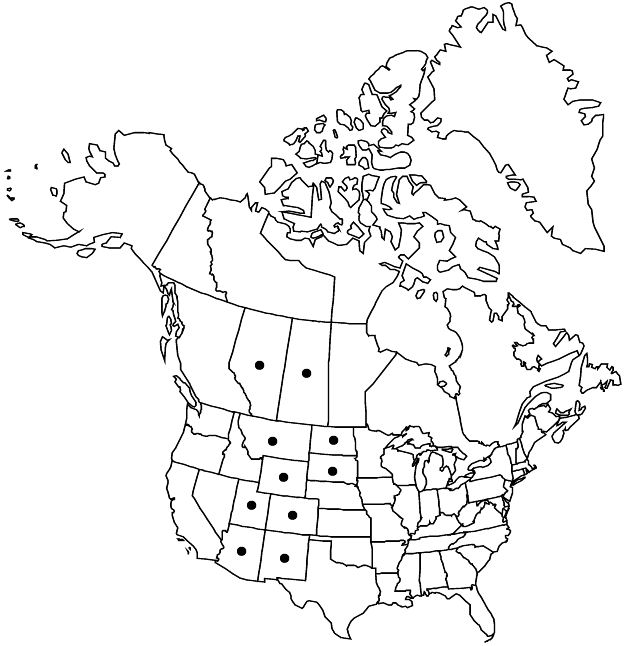Difference between revisions of "Potentilla concinna var. concinna"
FNA>Volume Importer |
FNA>Volume Importer |
||
| Line 19: | Line 19: | ||
|elevation=1300–3800 m | |elevation=1300–3800 m | ||
|distribution=Alta.;Sask.;Ariz.;Colo.;Mont.;N.Mex.;N.Dak.;S.Dak.;Utah;Wyo. | |distribution=Alta.;Sask.;Ariz.;Colo.;Mont.;N.Mex.;N.Dak.;S.Dak.;Utah;Wyo. | ||
| − | |discussion=<p>Variety concinna is the compact phase of <i>Potentilla concinna</i> with strictly palmate, short-toothed leaves that are often prominently bicolored. The variety occurs primarily in vernally wet meadows and similar situations in the Rocky Mountains of Colorado and New Mexico, and in forested areas of northern Arizona. Plants referable to <i></i>var.<i> concinna</i> also extend into the primary range of <i></i>var.<i> dissecta</i> (S. Watson) B. Boivin at least as far as Alberta and North Dakota. No vouchers have been located to confirm reports from Idaho (R. J. Davis 1952; B. C. Johnston 1980). The low elevation extreme is from Alberta; the highest elevations are in Colorado and Wyoming.</p> | + | |discussion=<p>Variety concinna is the compact phase of <i>Potentilla concinna</i> with strictly palmate, short-toothed leaves that are often prominently bicolored. The variety occurs primarily in vernally wet meadows and similar situations in the Rocky Mountains of Colorado and New Mexico, and in forested areas of northern Arizona. Plants referable to <i></i></i>var.<i><i> concinna</i> also extend into the primary range of <i></i></i>var.<i><i> dissecta</i> (S. Watson) B. Boivin at least as far as Alberta and North Dakota. No vouchers have been located to confirm reports from Idaho (R. J. Davis 1952; B. C. Johnston 1980). The low elevation extreme is from Alberta; the highest elevations are in Colorado and Wyoming.</p> |
|tables= | |tables= | ||
|references= | |references= | ||
| Line 43: | Line 43: | ||
|publication year= | |publication year= | ||
|special status= | |special status= | ||
| − | |source xml=https://jpend@bitbucket.org/aafc-mbb/fna-data-curation.git/src/ | + | |source xml=https://jpend@bitbucket.org/aafc-mbb/fna-data-curation.git/src/f6b125a955440c0872999024f038d74684f65921/coarse_grained_fna_xml/V9/V9_259.xml |
|subfamily=Rosaceae subfam. Rosoideae | |subfamily=Rosaceae subfam. Rosoideae | ||
|tribe=Rosaceae tribe Potentilleae | |tribe=Rosaceae tribe Potentilleae | ||
Revision as of 20:36, 24 September 2019
Stems 0.2–0.8(–1) dm, lengths 1/2–1.5(–2) times basal leaves. Basal leaves palmate; leaflets on tip or at least less than distal 1/10 of leaf axis, separate to touching, proximal pair not separated from others; distal 1/4–3/4 of central leaflets incised 1/4–1/2 to midvein, teeth (1–)2–4(–10) per side, 1–3 mm. Inflorescences (1–)2–6-flowered. Petals (4–)5–9 mm. Achenes 1.5–2 mm.
Phenology: Flowering early summer (Apr–Jun), occasionally second flowering late summer (Jul–Sep).
Habitat: Meadows and vernally moist openings in conifer and aspen woodlands, sagebrush rangelands, prairie hillsides, rocky outcrops and ridges
Elevation: 1300–3800 m
Distribution

Alta., Sask., Ariz., Colo., Mont., N.Mex., N.Dak., S.Dak., Utah, Wyo.
Discussion
Variety concinna is the compact phase of Potentilla concinna with strictly palmate, short-toothed leaves that are often prominently bicolored. The variety occurs primarily in vernally wet meadows and similar situations in the Rocky Mountains of Colorado and New Mexico, and in forested areas of northern Arizona. Plants referable to var. concinna also extend into the primary range of var. dissecta (S. Watson) B. Boivin at least as far as Alberta and North Dakota. No vouchers have been located to confirm reports from Idaho (R. J. Davis 1952; B. C. Johnston 1980). The low elevation extreme is from Alberta; the highest elevations are in Colorado and Wyoming.
Selected References
None.